The Nigerian military is among Africa’s most powerful militaries. It’s a respectable establishment, which protects citizens of this country. If you’re interested in joining the Nigerian Armed Forces (NAF), there are some requirements you need to meet.
One of them is to be familiar with the army ranks and symbols in the NAF. Also, for you to realize this dignifying goal, you need to get reliable information on how to apply, the salary structure, and related things.
For now, let’s discuss all you need to about Nigerian army ranks and symbols.
A Brief History of the Nigerian Army
The Nigerian Army was founded in 1960 as the foremost defense arm of the NAF and is solely responsible for land warfare. It’s under the control of the Nigerian Army Council, NAC.
The Royal West African Frontier Force, also called RWAFF, was established in 1900 in Nigeria. During World War 2 (1939–45), Nigerian troops, who were trained by the Great Britain, fought some battles with the 1st (West Africa) Infantry Brigade, the 81st as well as the 82nd (West Africa) Divisions that saw action in the East African Campaign (the Second World War) & in the Far East.
When the Nigerian Civil War ended sometime in 1970, the Nigerian Army had grown in strength from 18,000 infantry battalions & supporting units to roughly 126,000 in three (3) divisions. But there were no fundamental changes in the functions of the Federal Nigerian Army since its duty remained to subdue and defeat an organized enemy.
The Army is the arm of the Armed Forces receiving the smallest funds, and until recently, it was generally under-resourced, getting with lower budgets in comparison with other organizations that were unpredictably and irregularly disbursed.
During 2000–08, the military budget was less than 3% of total government spending and was increased to an average of 7.2% of government expenditure ($5–$6B) during 2009–14. However, this allocation still fell disproportionately below recurrent spending, which left very little for crucial capital investment.
The Nigerian Army has, since 2015, embarked on a huge procurement of arms & modernization for the force, taking the army into the 21st Century battlefield equipped with novel and modern weapons, in addition to better training as well as a new doctrine, which is focused on information-gathering, mobility & firepower. As of now, the Nigerian Army has more than 6,000 officers as well as 150,000 soldiers.
The Nigerian Military Structure
Owing to its size, it is not surprising that several hundred thousand troops are in the Nigerian Armed Forces (army, navy & air force). Like its fellow African country Algeria, there is an abundant domestic oil supply, easing the financial responsibilities of involvement in military conflict.
The Nigerian military has over 1,400 armoured vehicles, 6,000 logistical vehicles, 360 tanks, around 300 aircraft, and 25 high-powered naval vessels. It’s responsible for protecting citizens of this country from both internal and external threats as well as maintaining Nigeria’s structural integrity.
The NAF is divided into three service branches, which are the Nigerian Army, responsible for maintenance of peace on the land, enforcement of the law, and coordination of humanitarian missions; the Nigerian Navy, operative in the open waters to ensure the security of Nigeria and embark on rescue missions when necessary; and the Nigerian Airforce, providing air support, cargo transportation as well as other air missions.
This write-up is centred on only the Nigerian army symbols and the army ranks.
The Nigerian Army Flag
The Nigerian Army has its own flag, just like all the other service branches. The symbols in this flag convey a deep meaning. From the above picture, it consists of an eagle atop a shaded six-pointed star with Arabic writing on the red-black-red backdrop.
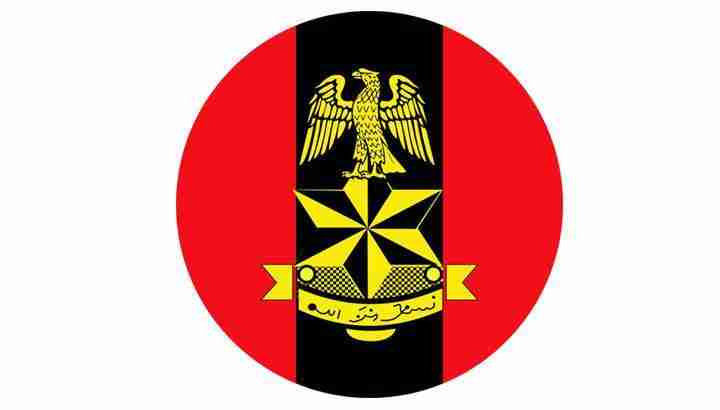
The eagle depicts the grace & power of the army; drawing a parallel to an eagle, in times of peace, the Nigerian Army keeps watch, and in times of war, it strikes the enemies with frightening precision.
The star stands for the unity of Nigeria. It was formed far back in 1914. The shadow-like symbol is a black star that is merged with the yellow one. The two (2) stars represent the Northern & Southern Protectorates, united in 1914 to create the entity called Nigeria.
The writing in the Arabic language is the Nigerian Army motto, which means “Victory comes from God alone.” The red colour represents the enemy forces. It’s customary in the North Atlantic Treaty Organization (NATO) to make use of this colour in their military elements.
As for the black colour, this represents the cavalry as well as other troops. Both colours are positioned like the green and white are on the Nigerian flag.
Related:
- Top 10 Visa-Free Countries for Nigerians
- God Is Good Motors (GIGM) — Terminal Locations, Price List, and Online Booking
- How to Register & Play Bet9ja Online
Nigerian Army Ranks and Symbols
The Nigerian Army has a well-defined rank structure, in which all positions have their own status, meaning, and signs. By merely looking at an officer’s uniform, you can determine pieces of information like who they’re, what they do, and even how much their take-home pay is. Here are the ranks in the Nigerian Army for commissioned officers:
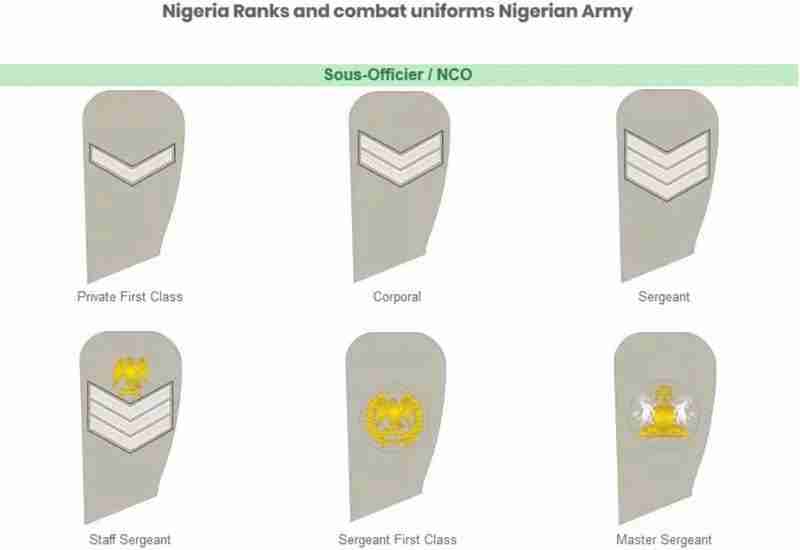
Recruit/Trainee
Starting with the lowest rank, this position is for those individuals that have just joined the army. They’re currently on the lowest level of hierarchy, and recruits don’t usually have insignia, whereas trainees could have one shoulder mark.
Lance Corporal
Coming next in the ranking is Lance Corporal, which is a bit higher than the recruit/trainee. But it’s still the lowest officer rank, and Lance Corporals also have one shoulder mark.
Corporal
This is the position of an individual, who’s responsible for a troop’s body. Corporals bear two (2) shoulder marks.
Sergeant
This is the rank of a junior non-commissioned officer. Sergeants bear three (3) shoulder marks.
Staff Sergeant
This position is directly above the Sergeant and is for a senior non-commissioned rank of the Nigerian Army. Staff Sergeants bear three (3) shoulder marks as well as a golden eagle on top.
Warrant Officer/Sergeant First Class
The insignia of this next rank is the golden eagle, which is surrounded by the matching golden crown made of olive leaves. Warrant Officers serve as assistants to Master Warrant Officer/Master Sergeant — the next rank.
Master Warrant Officer/Master Sergeant
Officers that have this rank are in charge of military equipment, and their symbol is the Nigerian Coat Of Arms. Here, the horses are silver, while the rest is golden. This rank concludes the non-commissioned level.
Second Lieutenant
The 1st rank from the officer hierarchy is the Second Lieutenant, and the term, “lieutenant”, means “substitute”. Lieutenants bear one (1) silver star on each of their shoulders, with the word, “star”, meaning a six-pointed star.
First Lieutenant
First Lieutenants bear two (2) vertically aligned silver stars on their shoulders and are deputies of the Captain.
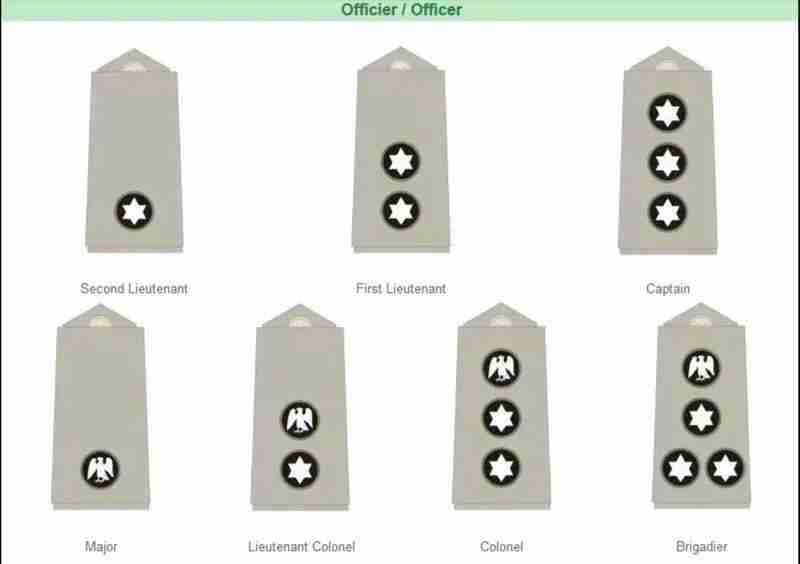
Captain
The captain is the highest rank among the tactical troop organization. These officers have three (3) vertically aligned silver stars on their shoulders.
Major
The Major represents the lowest field officer rank in the Nigerian Army. Such officers bear a silver eagle on each shoulder.
Lieutenant Colonel
This is the next rank and is a mid-level rank among the field officers. They have a vertically aligned silver star as well as a silver eagle on each shoulder. Lieutenant Colonels are deputies to the Colonel.
Colonel
Colonels are officers at the top of the field officer hierarchy. They are also at the bottom of the commissioned officer hierarchy and are responsible for the regiments. Such officers bear two (2) silver stars as well as a silver eagle (all vertically aligned) on each shoulder.
Brigadier general
They are in charge of commanding brigades and bear three (3) silver stars, forming a triangle with a silver eagle on top. The arrangement is on the two shoulders.
Major General
This is the next mid-level commissioned officer rank. They have a golden emblem of the crossed sword as well as a baton below a golden eagle on each shoulder.
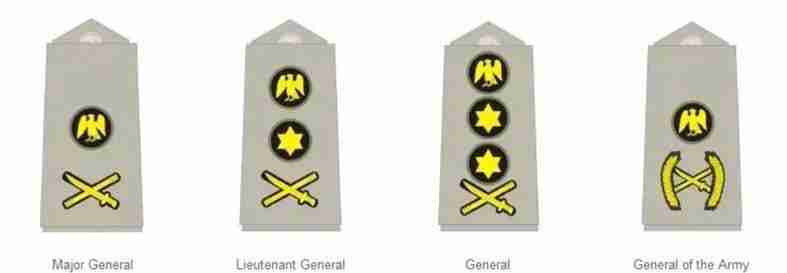
Lieutenant General
The Lieutenant General is the third-highest rank in the Nigerian Army. They are officers with the vertically aligned emblem of the crossed sword and baton, a star as well as an eagle, all in gold and on the two shoulders.
General
This is the second-highest rank and is practically the highest rank in the Nigerian Army. The General bears vertically aligned crossed sword & baton, two stars as well as the eagle, all in gold and on the two shoulders.
Army Field Marshal/General
Sitting atop the whole Nigerian Army is the Army Field Marshal/General of the Army, which unattainable rank as nobody has claimed it so far. For this reason, the General’s currently the highest rank in the Nigerian Army. Army Field Marshal bears an emblem of the crossed sword & baton, which is surrounded by two (2) branches as well as with an eagle on top, all in gold and on the two shoulders.
That is it: we have now come to the end of today’s post on all you need to know about the Nigerian Army ranks and symbols.
You’ve learnt a lot from this article, do not forget to share with your friends and family on Facebook, Twitter and WhatsApp. You can also follow us on Facebook and Twitter.
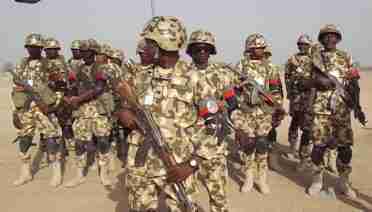
Leave a Reply
You must be logged in to post a comment.